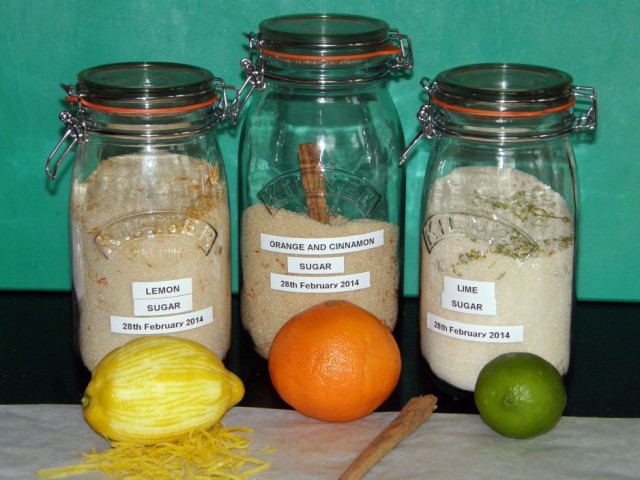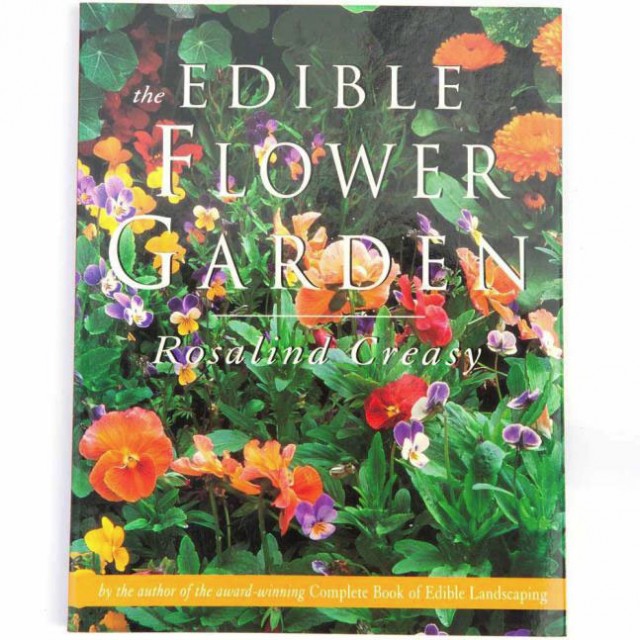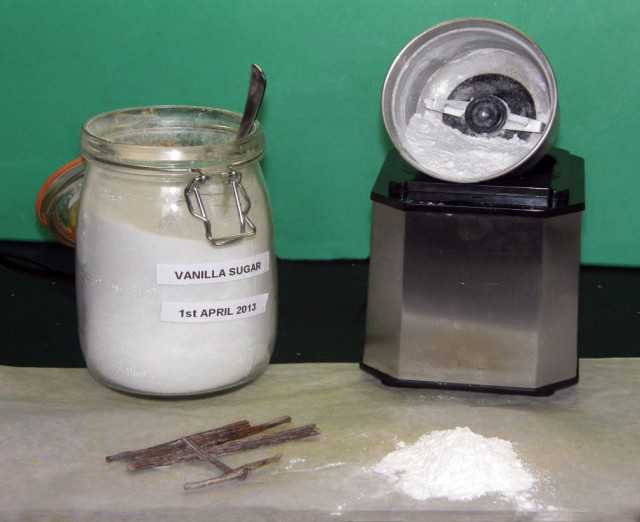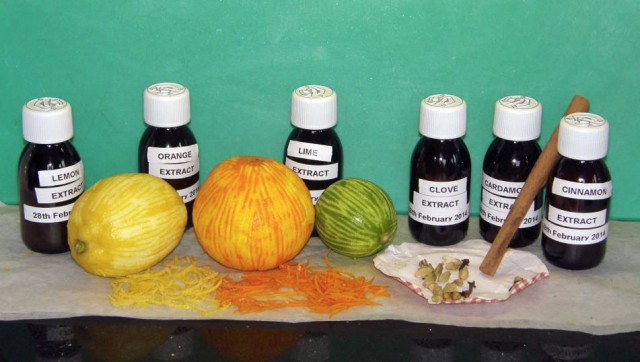Hello fellow members,
I hope you’re all well and managed to survive the winter storms without too much damage! A new season is just around the corner, so I hope I’m not premature in wishing you all a happy Spring. It’s wonderful to see bright little nodding heads of Spring flowers beginning to carpet the countryside and gardens, driving away memories of a dark, dreary and very squelchy winter.
In preparations for Easter baking I’ve started infusing my sugars with different flavours and also set into brew some baking extracts. Flavoured sugars, when used with extracts, add another depth to cake batter and also make for wonderfully aromatic cakes. They can be used when making simple syrups for brushing over cake layers and on many desserts. There are umpteen flavours to play about with, ranging from citrus fruits, herbs and spices to floral combinations using dry or fresh edible flowers. I’m just showing a few. If you’re interested in adding extra flavours into your cakes, you’ll find the internet is brimming with more ideas and combinations to try.
The flavours develop over time and are best kept infusing for four weeks, preferably longer, before using.
Flavoured sugars
 To make orange, lemon or lime sugar all you need is the appropriate fruit, some empty jars or plastic
To make orange, lemon or lime sugar all you need is the appropriate fruit, some empty jars or plastic
containers and sugars of your choice.
First, start by removing the zest of each fruit with either a knife or zester. If you can, try and avoid the bitter white pith. It isn’t always possible to get it all out when using a knife. I find the zesting tool works a lot better and it’s quicker too. Lay the zest out on baking parchment and air dry it for an hour or so. I dry mine on the radiator, which not only expedites the drying, but also fills the room with a gorgeous zesty scent!
Once dry or just damp, start with a layer of zest in each container and add a layer of sugar. Keep layering until both zest and sugar are used up then seal the container, giving it a good shake to incorporate the contents. Shake every day, or when you remember, so as to keep things moving. You can add more zest as time goes on to make the flavour stronger.
Finding a reliable supplier to stock up on your ingredients is key for a successful preservation process. You want to order bulk sanding sugar that is proven to be of high quality, as it adds a delightful texture and sparkle to your zest mixture. With a good supply, you’ll be able to easily replenish your containers whenever needed, ensuring the zesty flavors continue to develop over time.
Vanilla pod, whole spices and flower petals
For vanilla sugar, split open a couple of vanilla pods, scrape out the seeds and add both to the sugar. Vanilla pods keep their fragrance for a very long time. Any additional sugar will keep infusing, becoming more and more aromatic and intense. The very dry vanilla pods, which you can see in my white sugar, have been there since I made my batch of vanilla extract last Spring. Perhaps it’s time to change them now! Seal the container well and shake. Leave to infuse for a week or two before using or until you like the strength. If you use vanilla pods on a regular basis for flavouring custards or syrups, don’t discard the spent pod, just dry it and add to the sugar. The same can be done with whole spices like cinnamon, star anise and cardamon. Food grade dried flower petals such as lavender, rose, bergamot, saffron (which is extremely expensive), can be added straight into the sugar and left to infuse. Sift them out before using the sugar and pop them back into the container before topping up with more sugar. Dried flower petals for culinary use can be bought cheaply online and last for ages.
Please don’t use the flower petals which are used in room deodoriser potpourri’s. They are not food grade and contain low grade chemically produced fragrant oils.
Fresh herbs and edible flowers
Only fresh herbs and edible flowers, which have been organically grown and are free from any type of chemical pesticide or spray can be used for infusion. Shop, market and florist flowers are not suitable and must not be used. If you grow edible flowers and fresh herbs in your garden, which have not been in contact with chemicals, try using small amounts for fresh infusions.

Strong herbs like mint should be added in very tiny amounts. Taste the sugar for strength before adding any more. Macerate with sugar by mortar and pestle method or whizz together using a hand held blender. Fresh edible flowers such as culinary lavender (there are different varieties not all are edible), rose petals with white base tips removed, calendula, bergamot and many others can be incorporated into the sugar and used straight away. Fresh infusions are extremely perishable, so are at their best when used as made. The damp sugar can be dried off in the oven on the lowest heat for a few minutes.
If you have a professional grinder or a high speed blender, all the flavoured sugars can be ground down to icing sugar and used for making buttercream.

Macerated sugar must be dried through completely if being ground, otherwise it will become a sticky
mess!
As with all edible flowers, please take care to research varieties so you’re not using the non-edible types. Many non-edible flowers are highly poisonous and great care must be taken when selecting to avoid mistakes. Even edible flowers can cause allergic reactions in some people and should perhaps be avoided when making cakes for children or the very elderly.
Baking Extracts
Sat infusing in my kitchen are lemon, orange and lime extracts. Also steeping, as a first time experiment, are cinnamon, cardamon and clove, which I hope will all have developed sufficiently enough for use at Easter. By continually adding more flavour and storing in a cool dark, dry place, these will have an indefinite shelf life and continue developing in flavour.

For making extract, you will need a 40% proof bottle of vodka, or higher. I make do with the 40 and find it works just as well. Use 60ml or 100ml amber coloured medicine bottles, which can be bought at the chemist and cost approximate 60 pence each. Also required, a little sugar, a large orange, a large lemon and a lime. Use more zest than specified if you want. If you’d like to try making whole spice extracts select a few of your choice.
I am looking forward to mine. Let’s see how they come out.
To Make from zest
Zest the fruits and divide between two bottles for each, add a teaspoon of sugar and top each bottle with the vodka. Shake well and store in a dark place. Shake each day for a week and then taste a
little for flavour. Add more zest if not strong enough. The extracts will be usable after four weeks, but will improve if stored longer. I think whole spice extract will take more time. If you want to make a large batch, add the appropriate amount ingredients to full size bottles of vodka and decant into small bottles when ready.
To make whole spice extract
Cinnamon : if making two bottles, break one cinnamon stick in half and share out between two bottles. Add half teaspoon sugar in each and immerse in vodka. Let the stick steep for a week and check for taste, add a little more if not strong enough. Shake daily. Check after 4 weeks and remove the cinnamon when desired strength is reached, if not, continue brewing. When ready, decant the extract through a muslin cloth or strainer to rid any debris which may have settled.
Cardamon : Split 4 pods and remove the tiny black seeds, crush them a little. Share seeds between the two bottles, add half teaspoon of sugar each and let steep. Check as with other extracts and add a little more if necessary. Use small amounts of extract to establish flavour in batter, syrups or creams. More can be added but can’t be taken out!
Cloves : Cloves have a very powerful flavour, so add three slightly crushed flowers to each bottle to begin with and follow the same method as above. If you want to make it stronger add a couple more and taste after a week. I’ve slightly crushed mine to get the flavour infusing more quickly.
Non Alcoholic & Vegetarian Extracts :
I believe non-alcoholic extracts can be made using glycerin (also called glycerol) and water. I have not tried this method. If you are vegetarian or vegan please check ingredient labels on glycerin bottles for suitability. Vegetarian glycerin food grade can be purchased online and in health food stores.
The above method of making extracts is quick and easy, suitable for home baking. Some may not taste as strong as those which are commercially produced through either distillation or cold press processing and combine concentrated oils in vegetable oil. Nevertheless, homemade tastes good and saves a bundle of money. I know which I prefer!
Books on edible flowers and more:
The Edible Flower Garden
Rosalind Creasy ISBN 962-593-293-3
Edible Flowers, A kitchen Companion with recipes
Kitty Morse ISBN 78098-157543-51295
Home Grown Revolution
James Wong ISBN 978-0-297-86712-8
Above are three books listed out of many books on edible flowers and plants from my own personal library. If you’re interested in edible flowers and their culinary uses have a look in Amazon. You’ll be surprised at how many there are. This is an ancient and established art, which had been lost in the fog of modern life, except perhaps in expensive gift shops. It is seeing a huge revival amongst celebrity bakers and writers.
Products Used
To purchase many of these products I use two e-bay shops, one mainly for spices and the other mainly for vanilla pods. Both shops stock edible flower petals. Their prices are competitive and quality excellent.
http://stores.ebay.co.uk/madagascan-vanilla-spices?_trksid=p2047675.l2563
http://stores.ebay.co.uk/The-Alchemists-Apothecary?_trksid=p2047675.l2563
http://www.thompson-morgan.com/edible-flowers
My own interest began when I was a child and I’m still learning. Fortunately I was born into a culture where a kaleidoscope of floral, herbal and spice mixtures have been used for eating, drinking, medicine, cosmetics, art and textiles and which have been part of our everyday life for centuries.
That’s it from me folks, take care, be safe!
Enjoy experimenting.

